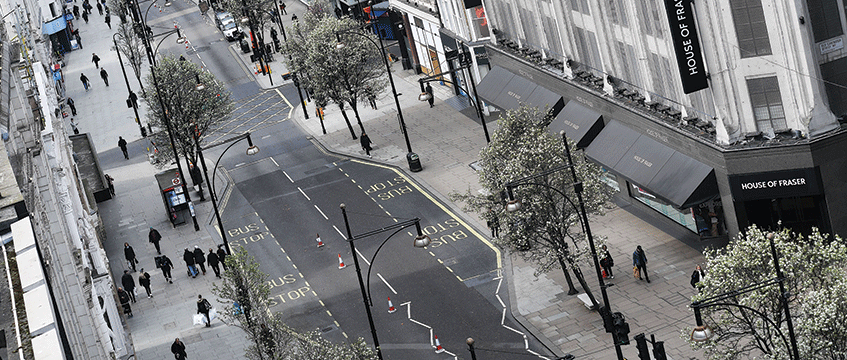As with every business sector and industry, Covid-19 is creating a long list of very immediate challenges and problems for commercial property owners. Whatever uncertainty we felt with Brexit, we are feeling it tenfold now.
While we can all assume that quarterly rents are going to be impacted, service charge payments will be delayed and many occupiers are going to struggle to reopen once allowed, it is hard to know what impact this will all have on the big-ticket business of dilapidations claims.
The potential problem
Dilapidation claims stem from the way a tenant uses a property. Should the tenant choose to alter the property, as many retail, industrial and office occupiers do, they pledge in their lease to return the property in the same condition that it was given. If a landlord does not feel that the property is being kept in a suitable condition, or if the property is not returned in adequate condition at the end of a lease, they can undertake remedial works themselves, and charge the cost back to the tenant.
Landlords rely on the ability to make dilapidation claims to put their properties back into a lettable state and maintain the infrastructure and fabric of assets. The most diligent of landlords will have worked in estimates and forecasts for likely claims on each of their assets as part of their budgets and financial planning. One of the biggest long-term financial dangers for them is, therefore, multiple occupiers exiting a space en masse in financial difficulty, leaving landlords with a diminished ability to claim for dilapidations. This could lead to gaping holes in their finances, running into the multi-millions across portfolios.
How to reduce exposure
While the risk of occupiers closing is not something that can be controlled, there are a number of measures that landlords can take to try to minimise risks during this difficult time. In order to keep tenants that survive for the long term, landlords must be willing to work with them, without sacrificing the need to maintain the value of their assets. There is a real need, now more than ever, to inject some humanity into this situation, to mitigate the effects of Covid-19 on businesses.
Good tenant relations
It is always important to stay close to tenants, but in these trying times, being up to date and understanding where your tenants are, business-wise, could not be more important. Understanding tenant liabilities – in this case, whether the tenant will be able to pay the dilapidations claims – is crucial.
Keep conversations relatively light – heavily leaning on an occupier that is already under duress may make them feel uncomfortable – and focus on getting a broad view of the situation. Honesty and openness are extremely important.
Lease monitoring
Landlords should examine their tenants’ leases carefully. This is especially important for landlords with large portfolios – it is easy to let things slip through the cracks.
One of the most common (and costly) culprits is notice periods. Leases generally require tenants to remove alterations, and landlords must often provide notice to do so within a prescribed time frame. Failure to provide notice could result in the landlord missing its window for reinstatement claims. If lease renewal negotiations are ongoing, it is key to accompany the formal notice with a well-considered letter explaining why it is necessary to serve notice in this manner. This maintains relationships while also protecting the landlord’s position.
Jervis v Harris clauses
Most leases contain a Jervis v Harris clause (Jervis v Harris [1996] 1 EGLR 78), which allows landlords to re-enter buildings to perform repairs. Under the clause, landlords must serve their tenants notice to perform a repair. This repair must be completed within a reasonable time (usually two to three months). If the tenant does not perform the repairs, the landlord is then allowed to enter the property, repair it, and be reimbursed for the cost of the repair as a debt.
This mechanism is often underutilised. At a time when property maintenance is likely to slip down the tenant’s list of likely expenditures, it may be useful for landlords to keep an eye on their assets and undertake necessary repairs in this manner. It also leaves less reliance on an end-of-term damages claim, where a landlord is heavily relying on a tenant’s financial liquidity.
Break clauses
A break will often be conditional on providing vacant possession or, in some cases, complying with covenants in the lease. With the current ability to undertake works significantly hampered by government-imposed restrictions, and much of construction grinding to a halt, how will tenants comply? In a significant number of cases, it is expected that they won’t, but it is yet to be seen if landlords will seek to frustrate break clauses on this basis. Careful consideration and legal input should be obtained as courts may potentially take a dim view of a landlord’s actions depending on the particular circumstances. A short-term lease extension may be a feasible alternative.
Time to be reasonable
The effect of Covid-19 will have far-reaching consequences, especially in the context of dilapidations matters. Given the potential financial difficulties many tenants are likely to face, careful consideration should be given to leaving all liabilities to an end-of-term dilapidations claim, and it may be time to consider dilapidations obligations more actively throughout the term. This option leaves neither landlords nor tenants out in the rain during times of commercial crisis.
Charlie Wildash is a partner at Hollis











